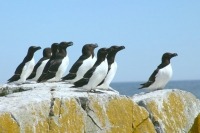
(Photo: Ralph Eldridge)
Razorbill or Lesser Auk
Alca torda
The razorbill is a stocky, medium-sized seabird. It has a black head, neck and back, with a white underside and a thick bill with a rounded tip and a vertical white stripe. It also has a distinctive white line that extends from the front of the eye to the bill. Non-breeding individuals have white colouration on the throat, cheek, and parts of the face. It can measure up to 43 centimetres in length.
Authority
Linnaeus, 1758
Classification Details
Phylum: Chordata (chordates); Subphylum: Vertebrata (vertebrates); Class: Aves (birds).
Habitat
This bird is a North Atlantic species. In the western Atlantic, its range extends from Greenland to North Carolina. In the eastern Atlantic, during breeding season, its range extends along British and Irish coasts. They overwinter at sea. They form large flocks in the outer Bay of Fundy (less common occurrence in the summer) and the Gulf of Maine. They nest on islands, rocky ledges, shorelines, and sea cliffs.
Diet
Feed on schooling fish, including capelin, herring, sprat, cod, and sandlance. Adults also feed on crustaceans and polychaetes but prefer crustaceans during the winter. They dive by using their wings to propel themselves underwater to catch prey. They can dive to depths greater than 100 metres.
Reproduction
Males and females, once bonded, tend to keep the same partner. Established pairs usually return to the same nest site each year. Most nest sites are partly to wholly enclosed: between boulders, in rock cracks, or on overhanging ledges on cliffs. Pairs usually make a simple nest out of small rocks and debris. Females lay a single egg from mid-May to early August. Females in the southern parts of the breeding range lay eggs earlier than those in the Arctic. Parents share incubation and chick care. Chicks hatch after about 35 days and leave the nest around 20 days after hatching. The breeding range is from the Arctic to Maine. The largest breeding colony in New Brunswick is on Machias Seal Island.
Fun Facts
May be the closest living relative of the great auk, which became extinct in the 1800s.
References
Audubon. Razorbill. Guide to North American Birds. https://www.audubon.org/field-guide/bird/razorbill Accessed online 18 January 2020.
Lavers J, Hipfner JM and Chapdelaine G (2009) Razorbill (Alca torda), version 2.0. In The Birds of North America (A. F. Poole, Editor). Cornell Lab of Ornithology, Ithaca, NY, USA. https://doi.org/10.2173/bna.635 Accessed online 18 January 2020.
Lin J (2002) Alca torda razorbill, Animal Diversity Web. https://animaldiversity.org/accounts/Alca_torda/ Accessed online 18 January 2020.
Sweet NA (2008) Alca torda Razorbill. In Tyler-Walters H. and Hiscock K. (eds) Marine Life Information Network: Biology and Sensitivity Key Information Reviews, [on–line]. Plymouth: Marine Biological Association of the United Kingdom. Available from: https://www.marlin.ac.uk/species/detail/2205 Accessed online 18 January 2020.
Van Guelpen L, Pohle G, Vanden Berghe E and Costello MJ (2005) Marine Species Registers for the North Atlantic Ocean. World Wide Web electronic publication. http://www.vliz.be/vmdcdata/narms/


